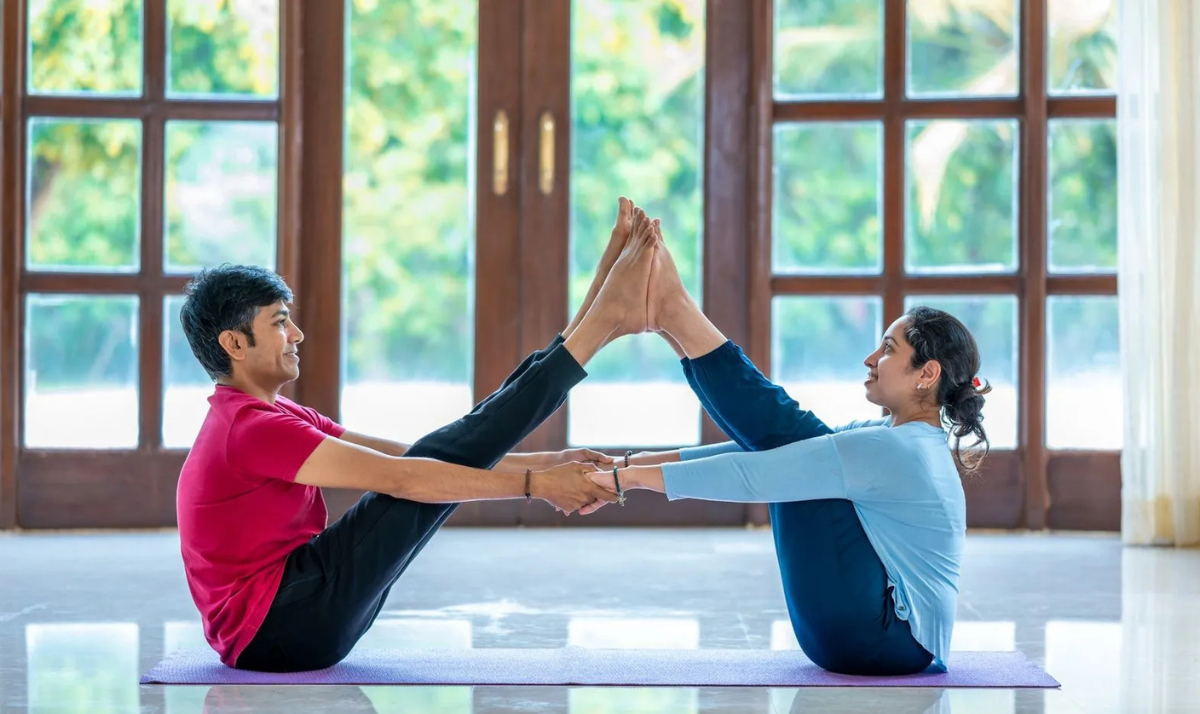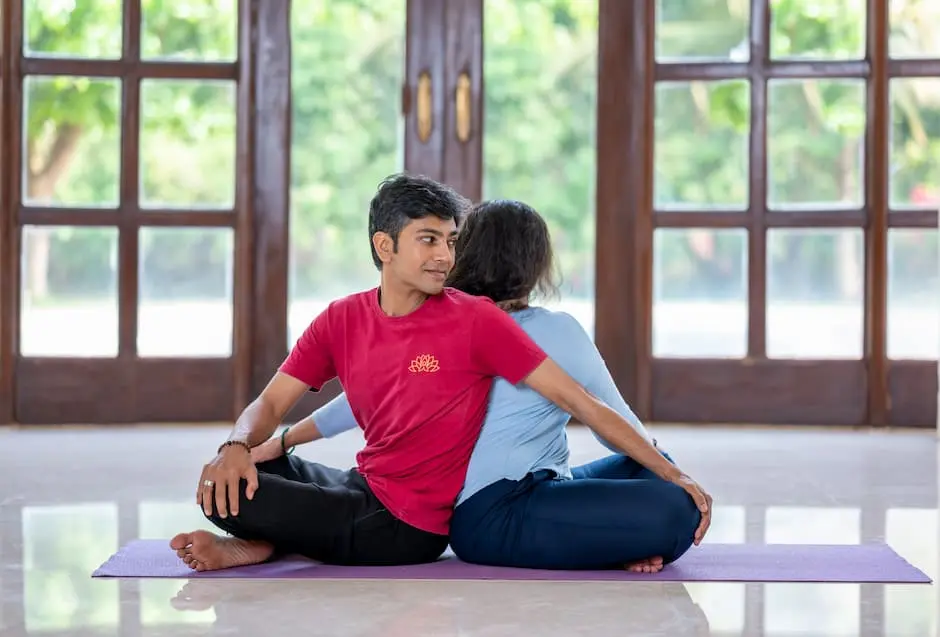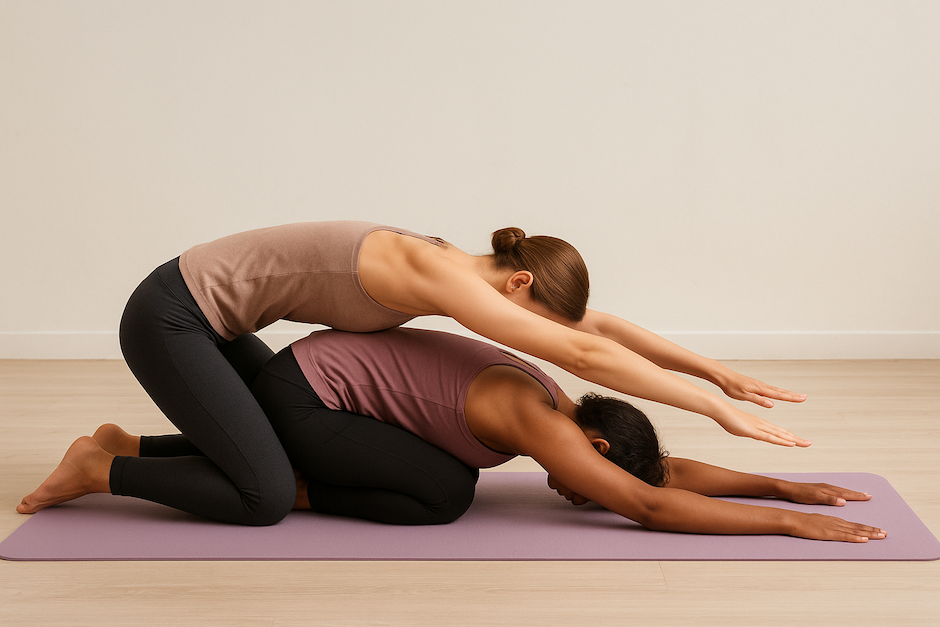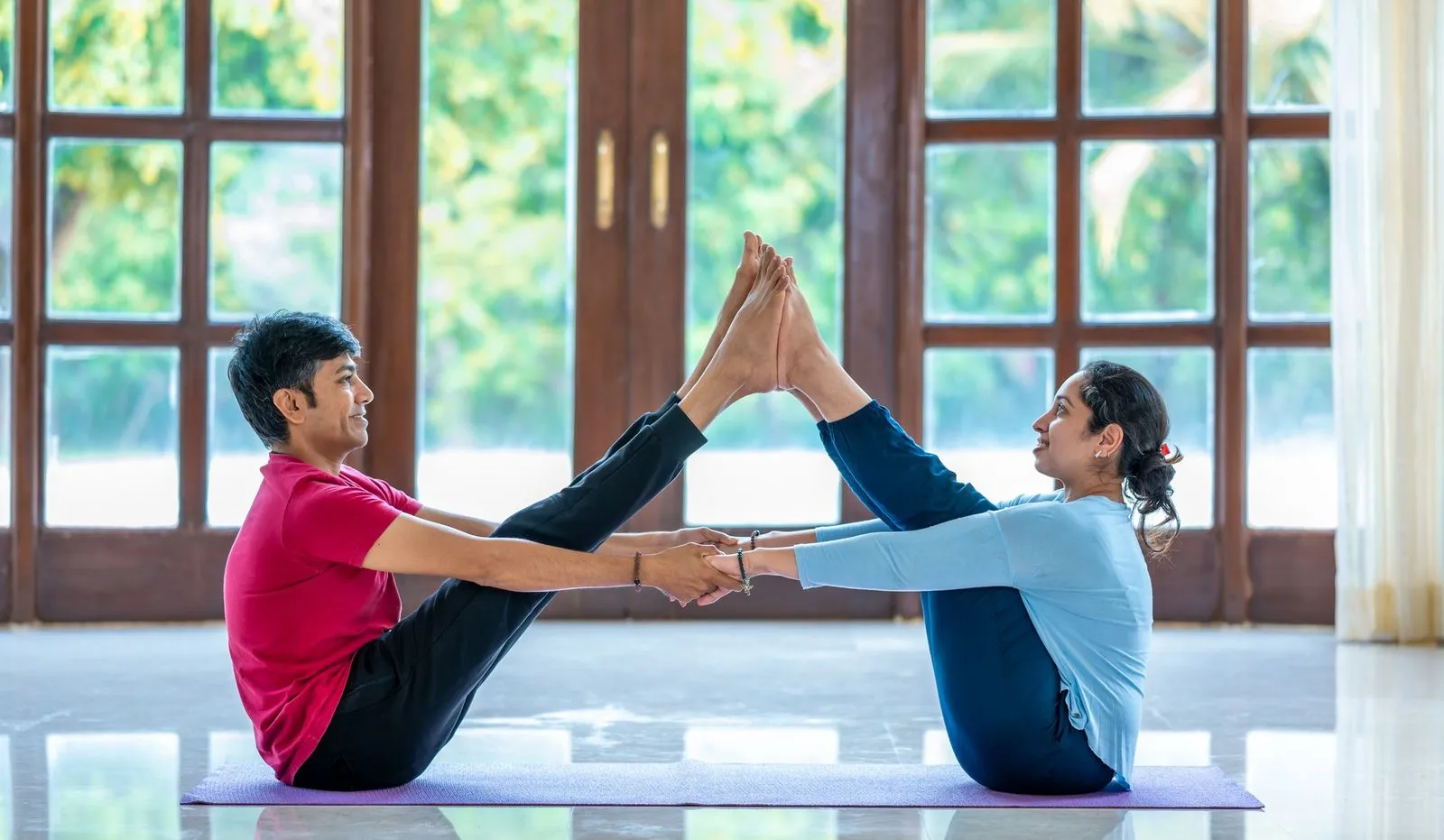

Partner yoga, also known as couples yoga or two-person yoga, transforms a solo yoga practice into a shared experience of trust, communication, and mindful movement. It involves two people performing yoga poses together, using each other’s bodies for balance, alignment, and gentle support.
Beyond flexibility and strength, partner yoga helps couples:
So, whether you and your partner are juggling long workdays, managing family life, or simply looking for a new way to connect, these 15 partner yoga poses invite you to slow down, communicate, and grow stronger together.
Before diving into the poses, take a few minutes to set the right foundation for your partner yoga practice. A mindful start not only keeps you safe but also makes the experience smoother and more enjoyable for both partners.

[inline-CTA-1]
Remember: partner yoga is about connection, not competition. Go slow, listen to each other, and enjoy the process.
These 15 partner yoga poses progress from gentle seated stretches to more dynamic balancing postures. Each pose includes step-by-step guidance, key benefits, and simple modifications for comfort.

Improves spinal mobility, digestion, and posture while encouraging mindful breathing.
Tip: Use your partner’s back as light resistance to deepen the twist gently.
Modification: If sitting cross-legged feels uncomfortable, extend one or both legs forward.

Gently stretches hips, back, and shoulders while calming the mind.
Tip: Communicate about pressure — Partner B should rest only part of their weight, not the full body.
Modification: Keep knees slightly apart or use a pillow between the hips and heels for comfort.
Deepens hamstring and lower back flexibility; builds connection through synchronized breath.
Tip: Keep a slight bend in your knees if hamstrings feel tight.
Modification: Use a yoga strap or towel to connect hands if you can’t reach comfortably.
Improves spinal flexibility and posture; encourages movement coordination.
Tip: Make eye contact or smile as you move—it helps synchronization and adds playfulness.
Modification: Place a folded blanket under knees if they’re sensitive.

Strengthens legs and glutes, improves coordination and balance.
Tip: Keep communication open—rise together slowly to avoid imbalance.
Modification: Hold the pose for just a few seconds if your legs fatigue quickly.

Strengthens core, hips, and lower back while improving balance and communication.
Tip: Keep a soft bend in the knees if hamstrings are tight. Smile—it helps you stay relaxed and steady!
Modification: Rest one foot on the floor or use a strap between hands if reaching is difficult.
Stretches hamstrings, shoulders, and spine while improving upper-body strength.
Tip: Communicate constantly—Partner A should say if the weight feels too heavy.
Modification: Partner B can rest their hands on A’s back without stepping up if balancing feels tricky.

Improves balance, focus, and lower-body strength; enhances synchronization.
Tip: Gaze into each other’s eyes—it helps maintain balance and focus.
Modification: Keep the back leg lower or slightly bent for added stability.

Builds core strength, coordination, and endurance.
Tip: Breathe evenly and communicate—this one’s about control, not endurance.
Modification: Keep Partner B in a regular plank beside A if the lift feels unstable.

Improves balance, coordination, and concentration while fostering harmony.
Tip: Focus your gaze forward and keep your breath steady—it helps balance both partners.
Modification: Keep toes on the floor if lifting the foot feels unstable.
Strengthens the back, opens the chest and shoulders, and enhances trust between partners.
Tip: Communicate before each lift — Partner A controls height and stability.
Modification: Practice the shape on the floor first to build confidence and alignment.
Builds upper-body strength, stability, and confidence; strengthens the bond between partners.
Tip: Keep communication flowing — eye contact helps stability and confidence.
Modification: Use a spotter if it’s your first time attempting this pose.
Deep hip opening, balance, and core engagement.
Tip: Move slowly into position — rushing can throw off balance and trust.
Modification: Try the pose on the floor individually before the partnered version.

Builds upper-body strength, focus, and coordination.
Tip: Trust and timing are key — communicate clearly on the count before lifting.
Modification: Practice against a wall before adding partner support.
Deep chest and shoulder opening, improved flexibility, and shared energy flow.
Tip: Never force a backbend — move slowly and exit together.
Modification: Use yoga blocks under the hands to ease shoulder pressure.
[inline-CTA-2]
Partner yoga is a powerful way to strengthen your mind, body, and relationships. When two people move, breathe, and balance together, they build trust, coordination, and calm.
Here are five evidence-based reasons to roll out your mats and practice together.
Practicing partner yoga helps couples tune in to each other through touch, breath, and rhythm. When you move in sync, you learn to pick up non-verbal cues, build trust, and offer support in subtle ways.
Research shows that shared physical activities — especially those requiring cooperation — can boost empathy and relationship satisfaction.
Partner yoga allows you to access deeper stretches than you might achieve alone — but safely. Your partner provides gentle resistance or support that helps muscles release gradually instead of forcing them.
Having a yoga partner makes it easier to stay consistent — and research backs this up. Studies show that exercising with a partner increases motivation and adherence to healthy routines.
When you practice together, yoga becomes a shared commitment, not a solo task on your to-do list.
Every partnered pose demands focus and coordination. As you stabilize each other, you strengthen the proprioceptive system — your body’s ability to sense its position and movement in space. Over time, this improves balance, posture, and physical confidence.
Physical touch, synchronized breathing, and eye contact during partner yoga help trigger the release of oxytocin — often called the “bonding hormone.”
This natural chemical reduces stress and anxiety while promoting feelings of safety and closeness. Even just a few minutes of gentle partner breathing or shared Savasana can calm the nervous system and lift your mood.
Partner yoga turns movement into connection, transforming a simple stretch into shared joy. Whether you’re looking to deepen your relationship, stay active together, or find a mindful break from busy workdays, these poses offer the perfect blend of trust, strength, and playfulness.
Absolutely! Most partner yoga poses are beginner-friendly and focus on trust, connection, and gentle movement, not flexibility. Start with seated or supported stretches, then progress as you grow more confident.
You only need a little space and two yoga mats. Start with simple poses like Seated Twist or Double Child’s Pose, focusing on slow breathing and open communication.
For extra safety and alignment help, join a live 1-on-1 online session with a certified instructor at MyYogaTeacher.
Choose comfortable, fitted clothing that stretches easily and stays in place when moving or supporting your partner. Avoid baggy tops or jewelry that can get in the way during balancing poses.
Some of the most popular poses for couples include:
These encourage eye contact, trust, and coordinated breath — the essence of emotional and physical connection.
If you and your partner are beginners, 2–3 times per week is ideal. Consistency helps improve coordination, flexibility, and communication. Even a 15-minute session after work can make a big difference in mood and bonding.
Yes! Practicing with a loved one reduces stress, improves focus, and releases feel-good hormones like oxytocin. The combination of breathwork, movement, and teamwork creates a unique sense of relaxation and connection.

Receive personalized guidance tailored to your unique fitness goals, live with a dedicated coach—no credit card required.